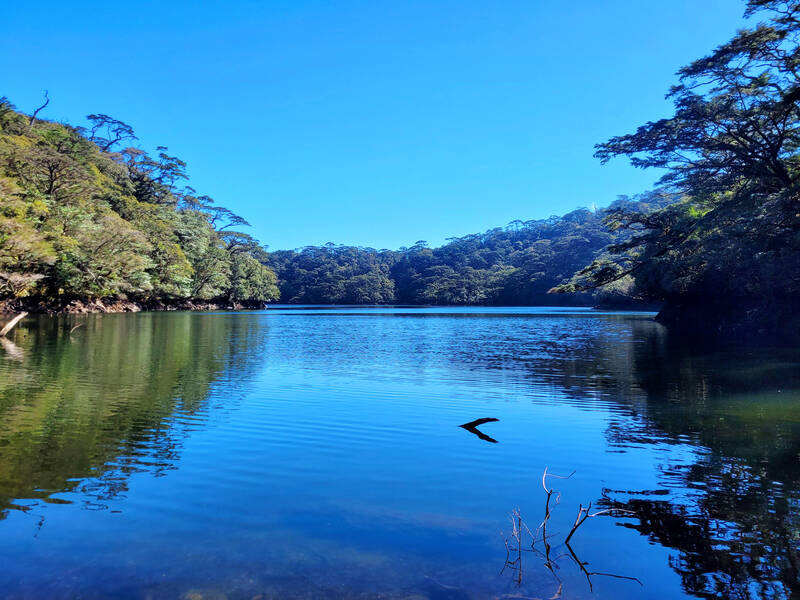Rukai legend tells of a young man and woman from different villages who fell in love, but were forbidden from pursuing the relationship, as the two villages were at war. Unable to bear the thought of living part, the couple made their way to a large lake near the top of a mountain and committed suicide. The villagers, moved by their sacrifice, decided to end their hostilities and to commemorate the young couple by naming the lake after the young woman and the stream pouring out of the lake after the young man. Nowadays, the lake is most commonly known as Big Ghost Lake (大鬼湖), to differentiate it from Small Ghost Lake (小鬼湖), which lies further south and has its own associated myth.
There are at least four feasible ways to get to Big Ghost Lake. You can walk (or pay NT$9,000 for a ride in an off-road vehicle) a long distance up the Ailiaobei River (隘寮北溪) in Pingtung County, then hike uphill for a day and a half to reach the lake from the south. Alternatively, you can spend a few days walking along the ridge on the north side of this same riverbed, eventually descending to the creek coming out of Big Ghost Lake and then going upstream.
Another way to reach this ridge starts at Duona (多納) in Kaohsiung’s Maolin District (茂林). Finally, you can reach the lake along the spine of the Central Mountains from the north or the south if you’re already up there for another reason. Most commonly, this would be a trip that also includes the Wanshan Holy Pond (萬山神池) to the north and/or Small Ghost Lake to the south. Our group was on just such a trip when we visited Big Ghost Lake.

Photo: Tyler Cottenie
No matter what approach you select, it’s no easy task, and the return trip may take 4 to 8 days, or even longer for more unusual routes. In decades past, this part of Taiwan was not so isolated. Logging operations were everywhere, traces of which remain to this day in the form of isolated sections of abandoned road, long cut off from the plains below by landslides. Nowadays, it’s hard to find a more remote-feeling place on the whole island. In fact, after a few pockets of signal on Day 1 as we left civilization behind, we couldn’t find a phone signal anywhere until Day 9 of our trip. This part of the Central Mountain Range is all well below 3,000 meters, not rising higher again until Beidawu Mountain (北大武山) much further south, which probably contributed to the lack of phone signal. It is wise for anyone visiting the Ghost Lakes to bring a satellite communication device.
THE APPROACH
Considering how long the journey to the lake is, if you can’t enjoy the journey itself, then your comparatively short time at the lake will not make this a worthwhile trip. No matter which way you choose to enter, the trek will involve a lot of fallen trees, slippery roots and rocks, deep holes between these roots and rocks, small landslides, dense vegetation to push through or a find a way around and long stretches of unmarked and often invisible trail. This is not a beginner’s route, so be sure the group is led by someone familiar with off-trail navigation at this elevation.

Photo: Tyler Cottenie
That being said, the forest in this area is lush and largely unspoiled, with long, damp stretches where the trees are draped in moss and lichen, interrupted by dry areas littered in red maple leaves and hemlock-covered ridges, with open views to Taitung and Pingtung counties. The primeval beauty of the area is hard to beat.
After a visit to the Wanshan Petroglyphs in Kaohsiung (Taipei Times, Jan. 13, page 13), our team first climbed up to the abandoned Chuyun Mountain Forest Road, eventually reaching Chuyun Mountain (出雲) itself along the spine of the Central Mountains, where we turned south. The forest road is one of the most extensive ever built, with long branch roads reaching deep into the mountains, even crossing over into Taitung. Aside from a motorcycle, an old shrine and a helipad, little evidence of human activity remains.
The following three days were entirely without trail: we chose the easiest path we could through grass and forest while maintaining the right direction. We had tracks loaded in our phones for some of this section, but these were not always reliable: apparently some people are able to directly ascend vertical walls with no ropes. Even the most gradual slope we could find to ascend some peaks was unnervingly steep on both sides, with only grass to grab onto to pull yourself up. Once again, this is not a beginner’s route. The one saving grace was that all of our campsites were very comfortable.

Photo: Tyler Cottenie
We made use of the flat forest road for a campsite one night, camped at Wanshan Holy Pond the next, and spent the last night before reaching Big Ghost Lake at Blue Lake. This is not a lake at all but rather a few shallow pools sitting at the bottom of a large depression shaped a bit like a volcanic caldera, which provides unobstructed view of the stars.
THE LAKE
Just to the north of Big Ghost Lake itself are two smaller lakes (East Pond and West Pond), which we reached after a short downhill walk the next morning. Despite their small size, these lakes are both quite beautiful and worth spending some time at. On a clear, calm day, the reflection of the hemlocks on the surface of these ponds is a soothing sight. A large flat area between the ponds serves as a useful year-round campsite. Be careful when walking near the shore of these ponds as the ground is very soft and wet and it’s possible to lose a shoe to the mud.

Photo: Tyler Cottenie
We pushed on and soon reached the west shore of Big Ghost Lake proper. During the winter, when the water level is about two meters lower than the summer, there is a wide flat gravel area here that serves as a perfect campsite or rest spot. What stands out at first glance is the sheer size of Big Ghost Lake — several times larger than the other so-called lakes in Taiwan’s high mountains. As a Canadian, this is perhaps the only one I think deserves to be called a lake and not a mere slough. Seeing the blue sky reflecting on its 12-hectare surface almost makes the whole arduous journey here worth it.
The water is clear and definitely swimmable, as long as you mentally prepare yourself for the cold shock. We were here on a sunny winter day but the air temperature was only 5°C and the water not much warmer. If you drown here, there’s no recovering your body: the lake reaches a depth of 65 meters in the winter and 67 meters in the summer.
All around the lake, a bare band of rock indicating the range of this regular fluctuation is visible. Look behind the gravel beach and you’ll see a heavily eroded rock chute where the lake’s water overflows in the summer, when the lake level rises and covers the gravel beach. This, the start of the Shanhuanunu River (山花奴奴溪), is where the Romeo and Juliet of Rukai legend are forever linked.

Behind a car repair business on a nondescript Thai street are the cherished pets of a rising TikTok animal influencer: two lions and a 200-kilogram lion-tiger hybrid called “Big George.” Lion ownership is legal in Thailand, and Tharnuwarht Plengkemratch is an enthusiastic advocate, posting updates on his feline companions to nearly three million followers. “They’re playful and affectionate, just like dogs or cats,” he said from inside their cage complex at his home in the northern city of Chiang Mai. Thailand’s captive lion population has exploded in recent years, with nearly 500 registered in zoos, breeding farms, petting cafes and homes. Experts warn the

The unexpected collapse of the recall campaigns is being viewed through many lenses, most of them skewed and self-absorbed. The international media unsurprisingly focuses on what they perceive as the message that Taiwanese voters were sending in the failure of the mass recall, especially to China, the US and to friendly Western nations. This made some sense prior to early last month. One of the main arguments used by recall campaigners for recalling Chinese Nationalist Party (KMT) lawmakers was that they were too pro-China, and by extension not to be trusted with defending the nation. Also by extension, that argument could be

Aug. 4 to Aug. 10 When Coca-Cola finally pushed its way into Taiwan’s market in 1968, it allegedly vowed to wipe out its major domestic rival Hey Song within five years. But Hey Song, which began as a manual operation in a family cow shed in 1925, had proven its resilience, surviving numerous setbacks — including the loss of autonomy and nearly all its assets due to the Japanese colonial government’s wartime economic policy. By the 1960s, Hey Song had risen to the top of Taiwan’s beverage industry. This success was driven not only by president Chang Wen-chi’s

Last week, on the heels of the recall election that turned out so badly for Taiwan, came the news that US President Donald Trump had blocked the transit of President William Lai (賴清德) through the US on his way to Latin America. A few days later the international media reported that in June a scheduled visit by Minister of National Defense Wellington Koo (顧立雄) for high level meetings was canceled by the US after China’s President Xi Jinping (習近平) asked Trump to curb US engagement with Taiwan during a June phone call. The cancellation of Lai’s transit was a gaudy